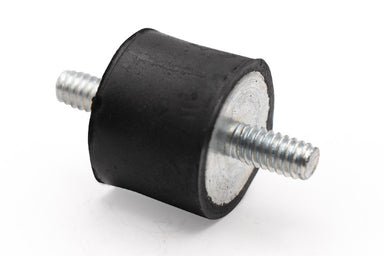Cylindrical Vibration Isolators
At Enterprise Rubber, we manufacture cylindrical vibration isolators of varying configurations. From rubber bump stops that protect against metal-on-metal contact in industrial machinery to vibration mounts that isolate machinery from its environment, we have the threaded rubber solutions you need to ensure your operation runs smoothly.
Rubber has excellent damping properties, which means it can absorb and dissipate the energy produced by vibrations, preventing them from propagating further through a system. When used in vibration mounts, isolators, or bushings, rubber can significantly reduce the transmission of vibrations, leading to improved stability and the protection of sensitive equipment.
It's essential to select the right type of rubber and design the vibration-absorbing components correctly based on the specific requirements of the application. Factors such as the frequency and magnitude of vibrations, the load-bearing capacity, and the environmental conditions will all influence the effectiveness of the rubber in stopping or reducing vibrations.
Whether in industrial machinery or precision equipment, rubber is a valuable tool for managing and controlling vibrations, making systems more reliable, comfortable, and efficient.
Rubber Bump Stops
Rubber bump stops play a critical role in preventing damage, absorbing shock, and enhancing stability in various mechanical systems, particularly in industrial sectors.
The primary purpose of these bump stops is to limit the motion of a moving component, absorb energy from impact, and prevent excessive compression or extension of the system. They act as buffers between two surfaces, effectively reducing the force and stress transmitted between them.
Rubber bump stops find applications in industrial machinery and equipment. In manufacturing settings, bump stops are used to prevent the overtravel of moving parts, safeguarding both the machinery and the products being manufactured.
We manufacture rubber bump stops in various shapes, sizes, and configurations to suit specific needs. Depending on the application, softer or harder rubber compounds may be chosen to provide the optimal balance between cushioning and resistance to compression.
Rubber Vibration Mounts
Rubber vibration mounts are used to reduce and control the transmission of vibrations in various applications. These mounts are designed to isolate sensitive equipment, machinery, or structures from external vibrations, ensuring smoother operation, improved performance, and increased longevity.
Vibration mounts are typically made from high-quality rubber compounds that possess excellent damping properties. The rubber's elasticity and ability to absorb energy make it an ideal material for mitigating vibrations. These mounts come in a variety of shapes and sizes, with specific designs tailored to suit the unique needs of different systems.
In industrial settings, machinery can generate vibrations during operation. Excessive vibrations can lead to various issues, including reduced precision, accelerated wear and tear, and even structural damage. Vibration mounts act as a barrier between the machine and its foundation or surrounding environment, effectively isolating the machine.
The selection of the appropriate rubber vibration mounts depends on several factors, including the weight and size of the equipment, the frequency and magnitude of vibrations, and the specific environment in which the mounts will be used. Some mounts are designed to provide both vibration isolation and shock absorption capabilities, making them versatile for a wide range of applications.
Bushings
Bushings are integral components used in mechanical systems to provide cushioning, reduce friction, and absorb shocks and vibrations. These versatile components consist of a cylindrical shape made from high-quality rubber material, typically bonded to a metal sleeve or core. The combination of rubber's elasticity and the support of the metal core makes bushings essential in various applications.
In industrial applications, bushings are used to isolate machinery and equipment from vibrations, reduce noise, and protect components from excessive friction. For example, in manufacturing plants, these bushings are often employed in conveyor systems, where they provide a flexible and durable connection between moving parts, preventing metal-to-metal contact and minimizing the transmission of vibrations throughout the system.
